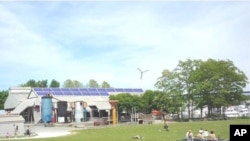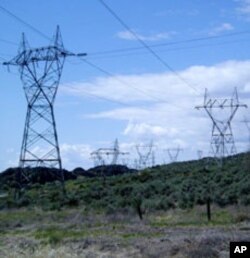National and state governments around the world have been trying out various incentives and subsidies to promote clean renewable energy but the global economic slowdown has hurt the ability of many governments to dole out public funds for that purpose.
Yet the desire to achieve energy independence and cut greenhouse pollution remains strong.
A green energy incentive that relies not on tax money, but rather on ratepayer funds was pioneered in continental Europe, and is now getting a hard look in many countries around the world, including the United States.
Most of the electricity Americans use is produced by coal, natural gas, or nuclear generation. Some mountainous regions benefit from hydropower. Less than four percent of the nation's electricity demand is met with renewable sources like solar and wind power.
Hundreds of electric utility companies are trying to burnish their green credentials by offering customers the option of supporting alternative energy. A 'green power' program in the Seattle area regularly invites customers to pay $4 to $10 extra per month to switch to clean energy.
Most of the money would help pay for the utility's new wind farms. But nationwide, the percentage of customers who've signed up for these voluntary programs is tiny.
Click to Listen:
Washington State Representative John McCoy says renewable energy needs a bigger push. "We're looking to get off fossil fuel generation, whatever it might be, and we need to bring these newer technologies in. We need to move on."
McCoy believes the best way to get more solar, wind and tidal power on the grid is to offer renewable energy generators a government guarantee.
Ensuring a market for a new type of producer
Effectively, the state would say if you build it, the local utility must buy the juice. And not only that, the utility must agree to a long-term contract that covers power generation costs, plus a decent profit.
Solar developer Stanley Florek of Seattle says the fixed, premium purchase price gives alternative energy suppliers assurance they'll recover the high costs they pay upfront. "As a result," he points out, "you may be foolish not to have a solar system or wind farm in your neighborhood, because that property is sitting there not making money for your neighborhood."
This incentive policy is most commonly called a feed-in tariff. Variations of it have passed recently in Vermont, California, and Oregon. A Congressman from the state of Washington is preparing national legislation.
Supporters are trying to duplicate successes in Europe, especially Germany. Christian Maass, Hamburg's Secretary for the Environment, looks back over 10 years, and says the program has worked well.
"Since we have introduced the feed-in tariff, we have seen a strong increase in the production of power from wind, from biomass and from solar power. Also, we have seen hundreds of thousands of jobs growing in Germany."
However, he acknowledges that Germans are paying a price for their renewable energy. Solar power, in particular, is much more expensive than other sources of electricity.
"But if you look at the price and if you look at the benefit and you compare that, it's worth it. So I can only recommend from the German experience that it's good, that it's something to copy from."
Utilities are allowed pass on their higher energy acquisition costs to consumers. And Hamburg resident Patrick Ulmer says Germans routinely complain about high energy prices. "Basically, what the consumer notices is that prices had gone up. That obviously is not a good thing. But I don't think that many people made the link to feed-in tariffs because of solar energy."
Economic storm clouds disrupt solar power
European incentive programs threatened to spin out of control when solar module prices dropped - decreasing producers' costs - while the rates utilities had to pay to buy that power stayed high. Investors flooded in to lock in high profits.
Last summer, Spain abruptly capped how many systems could sign up. In Germany this winter, the governing Christian Democrats proposed steep rate cuts to try to balance the market. Shares in solar energy companies promptly plummeted worldwide.
In the U.S., electric utilities lead the opposition to copying this rate structure, and to mandating purchases of alternative power. Dave Warren of the Washington Public Utility District Association notes electricity demand fell during the recession and may stay down, thanks to conservation. And then, "we would be forced to buy power that we don't need and idle existing generation or have hydro[power] that is very cost effective -- very cheap, actually -- being replaced by very expensive power." He adds it is ratepayers, not taxpayers, who shoulder the cost of this renewable energy incentive, and any rate increases are "tough to swallow," especially now.
In Germany, the above market price paid to wind and solar farm owners adds about two to five Euros to the average household's monthly power bill. Dave Warren offered a wide range for how much a similar policy might cost American consumers. He estimates rates in his home state could go up by as little as 0.03 percent to as much as 15 percent, depending on how many customers a utility company has to spread the costs across.










